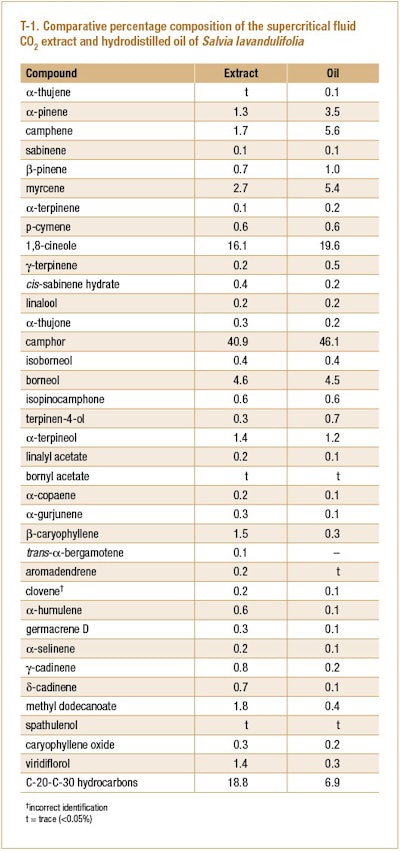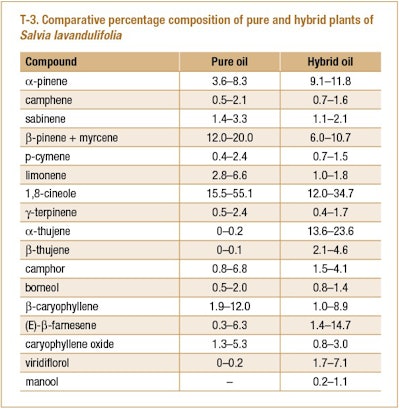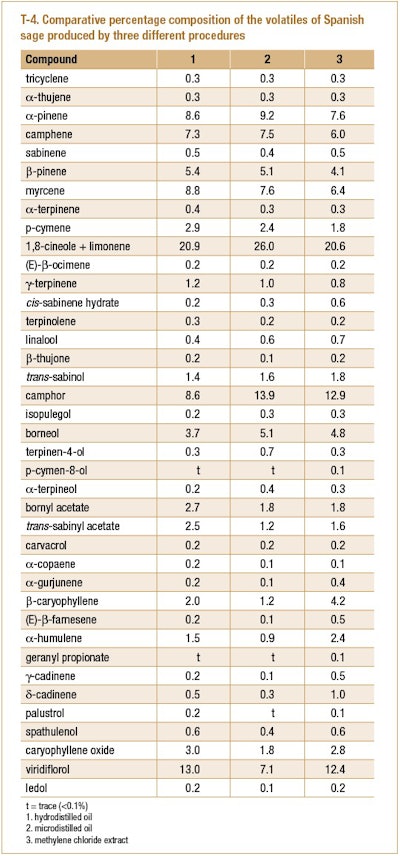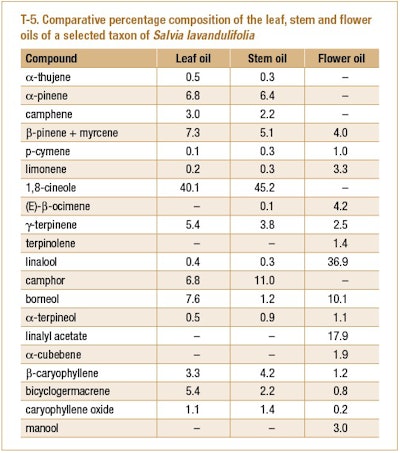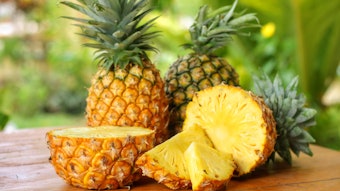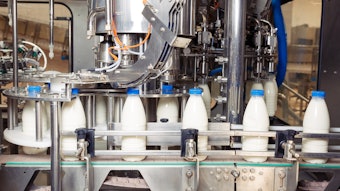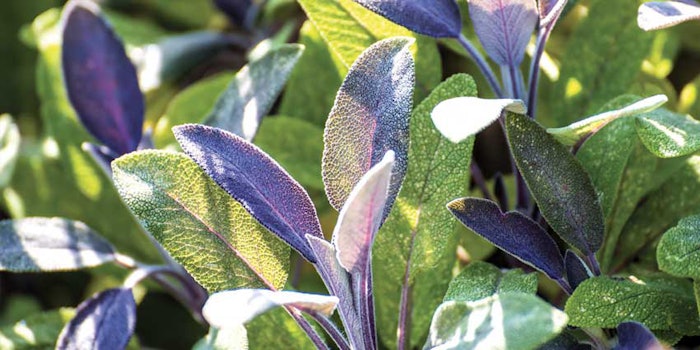
The botanical origin of Spanish sage oil is Salvia lavandulaefolia Vahl (or S. lavandulifolia). Spanish sage oil is exclusively produced from plants that can grow as an alternative and sustainable crop in poor soil throughout the semi-arid areas of Central Spain. It is estimated that ca. 30 metric tonnes of oil are produced annually. The unequivocally characterized constituents of Spanish sage oil that were previously reported (Lawrence, 1980, 1985, 1988, 1990, 1998, 2001, 2007 and 2010), which are listed in elution order from an non-polar capillary GC column can be seen as follows:
tricyclene (<0.1–0.8%)
α-thujene (<0.1–0.7%)
α-pinene (19–20.4%)
camphene (0.2–14.3%)
sabinene (<0.1–3.8%)
β-pinene (0.1–37.8%)
myrcene (0.4–15.6%)
α-phellandrene (<0.1–5.0%)
α-terpinene (<0.1–1.8%)
p-cymene (<0.1–4.6%)
limonene (0.5–35.3%)
1,8-cineole (1.2–58.7%)
(Z)-β-ocimene (<0.1–2.9%)
(E)-β-ocimene (<0.1–1.1%)
γ-terpinene (<0.1–1.5%)
cis-sabinene hydrate (0.1–1.7%)
terpinolene (<0.1–0.8%)
linalool (0.2–11.2%)
α-thujone (<0.1–11.1%)
β-thujone (<0.1–2.9%)
cis-sabinol (<0.1–2.5%)
camphor (0.4–38.9%)
borneol (<0.1–23.8%)
terpinen-4-ol (<0.1–2.4%)
α-terpineol (<0.1–8.4%)
nerol (<0.1–0.6%)
geraniol (<0.1–0.8%)
linalyl acetate (<0.1–5.8%)
bornyl acetate (<0.7–7.7%)
cis-sabinyl acetate (<0.1–12.8%)
α-terpinyl acetate (<0.1–15.5%)
α-cubebene (<0.1–2.8%)
α-copaene (<0.1–0.7%)
geranyl acetate (<0.1–0.7%)
α-gurjunene (<0.1–0.7%)
cis-α-bergamotene (<0.1–0.2%)
β-caryophyllene (<0.1–15.0%)
trans-α-bergamotene (<0.1–0.8%)
aromadendrene (<0.1–2.5%)
α-humulene (<0.1–6.2%)
allo-aromadendrene (<0.1–0.4%)
ar-curcumene (0.1–0.9%)
viridiflorene (<0.1–0.3%)
γ-cadinene (<0.1–1.0%)
δ-cadinene (<0.1–2.7%)
spathulenol (<0.1–3.4%)
caryophyllene oxide (0.1–3.8%)
viridiflorol (<0.1–11.0%)
humulene epoxide II (<0.1–3.1%)
Langa et al. (2008) examined the parameters for the supercritical fluid CO2 extraction of the dried aerial parts of Spanish sage in full flower. They found the best results were achieved at a pressure of 90 bar, a temperature of 40°C, a flow rate of 1.32 kg/hr and a particle size of 0.8 mm. This extract was analyzed by GC/MS only. The results were compared with those of a hydrodistilled oil (4 hr distillate time) using a 40 g sample of the same raw material sample.
A summary of the comparative analyses are shown in T-1.
Twenty collections of S. lavandulifolia were harvested from fully flowering plants from Cuenca, Albacete and Guadalajara (Spain) by Herraiz-Penalver et al. (2010). Oils were separately produced from each collection by steam distillation with cohobation for 8 hr. Each oil was analyzed by GC/MS only resulting in the following oil composition range:
tricyclene (0.1%)
α-thujene (0.1–0.9%)
α-pinene (6.7–23.2%)
camphene (1.4–4.6%)
sabinene (0.1–2.7%)
β-pinene (3.8–19.2%)
myrcene (0.9–2.4%)
3-octanol (0–0.1%)
2-octanol (0–0.2%)
α-phellandrene (0–0.3%)
α-terpinene (0.1–1.2%)
p-cymene (0.8–5.2%)
limonene (0.8–16.6%)
1,8-cineole (6.4–34.5%)
(Z)-β-ocimene (0.1–1.2%)
(E)-β-ocimene (0–0.2%)
γ-terpinene (1.1–6.9%)
cis-sabinene hydrate (0.1–0.5%)
terpinolene (0.2–0.7%)
trans-sabinene hydrate (0.1%)
linalool (0.1–0.3%)
α-fenchyl alcohol (0–0.1%)
β-thujone (0–0.2%)
α-campholenal (0–0.1%)
trans-limonene oxide (0–0.3%)
camphor (0–15.4%)
borneol (1.4–8.7%)
terpinen-4-ol (0.5–1.0%)
p-cymen-8-ol (0–0.2%)
α-terpineol (0.3–0.1%)
dihydrocarvone* (0.1–0.8%)
verbenone (0–0.4%)
nerol (0–0.1%)
4-isopropylbenzyl alcohol (0.1–0.4%)
myrtenyl acetate (0–0.1%)
carvone (t)
geraniol (0–0.1%)
geranial (t)
bornyl acetate (0.2–2.0%)
sabinyl acetate* (0–0.5%)
3-methyl-4-isopropylphenol (0.1–0.3%)
carvacrol (0–0.2%)
α-terpinyl acetate (0–0.7%)
α-cubebene (0–0.5%)
eugenol (0–0.1%)
geranyl acetate (0–0.1%)
(Z)-jasmone (t)
α-gurjunene (0–0.3%)
β-caryophyllene (1.5–8.1%)
aromadendrene (0–0.8%)
α-humulene (0.1–3.9%)
allo-aromadendrene (0–0.8%)
γ-selinene (0.1–0.2%)
γ-muurolene (0.1–0.3%)
β-ionone* (0–0.2%)
bicyclogermacrene (0.2–1.4%)
α-muurolene (0–0.2%)
δ-cadinene (0.1–1.7%)
spathulenol (0.1–2.4%)
caryophyllene oxide (0.4–5.6%)
viridiflorol (0.1–9.7%)
t = trace (<0.1%)
*correct isomer not identified
The aerial parts of Spanish sage plants were collected from 4-year-old plants for four seasonal stages (summer [July], autumn [November], winter [February] and spring [May]) over the entire vegetative cycle of the plants. Air-dried plant material from each season was subjected to steam distillation for 3 hr. The oil yields were determined to be 1.4% (summer), 2.7% (autumn), 1.7% (winter) and 0.9% (spring) by Usano-Alemany et al. (2012). Each oil was separately analyzed using GC-FID and GC/MS. The results of the analyses can be seen in T-2.
Twelve individual S. lavandulifolia plants were gathered from wild populations in Cuenca, Spain and grown under identical culture conditions by Usano-Alemany et al. (2014a). Oils were produced from these plants that were harvested from three different phonological stages (vegetative, full flowering and mature seed stages) over three seasons by 3 hr hydrodistillation. The oils were analyzed using GC-FID and GC/MS. The 13 selected constituents ranged in composition as follows:
α-pinene (1.5–34.3%)
camphene (0.2–4.9%)
sabinene (0.1–4.4%)
β-pinene+myrcene (8.1–25.0%)
limonene (2.5–25.1%)
1,8-cineole (3.0–52.5%)
camphor (0.6–19.9%)
borneol (0.1–4.5%)
β-caryophyllene (1.4–8.9%)
spathulenol (0–2.8%)
caryophyllene oxide (0.3–4.1%)
viridiflorol (0–5.4%)
Usano-Alemany et al. (2014b) also examined the range in composition of 13 selected constituents in oils produced from wild growing genotypes from Cuenca, Spain. The compositional range data was determined to be as follows:
α-pinene (1.1–23.6%)
camphene (0.2–4.5%)
sabinene (0.1–4.8%)
β-pinene + myrcene (6.7–27.7%)
limonene (2.2–25.2%)
1,8-cineole (5.7–62.7%)
borneol (0.1–7.7%)
camphor (0.6–28.7%)
β-caryophyllene (0.6–24.0%)
caryophyllene oxide (0.1–9.7%)
spathulenol (0–6.7%)
viridiflorol (0–13.9%)
Herraiz-Penalver et al. (2015) collected Spanish sage plants in full flower from an experimental field in Junta de Communidades de Castilla-La Mancha (Cuenca, Spain). These plants were growing in the vincinity of Salvia officinalis. The authors examined the essential oils of pure oils of S. lavandifolia and found some plants that were spontaneous hybrids of S. lavandulifolia × S. officinalis oils. The oils, which were produced from the pure hybrid plants by hydrodistillation for 4 hr—were subjected to analysis by GC/MS and retention indices only. The results of these analyses are presented in T-3.
Méndez-Tovar et al. (2015a) compared the compositions of volatiles produced from full flowering Spanish sage plants using hydrodistillation, microdistillation and methylene chloride extraction using GC-FID and GC/MS as their methods of analysis. The results of this comparative study are shown in T-4.
In addition, trace amounts (<0.1%) of α-phellandrene, α-campholenal, myrtenal, 2-undecanone and isobornyl acetate were found in the volatiles of the three isolation procedures, while (E)-β-ocimene and pinocarvone were found as trace constituents only in the oils.
Méndez-Tovar (2015b) examined the oil composition of 12 Spanish sage populations using GC-FID and GC/MS. It was found that the oils from the same 12 populations over three seasons ranged as follows:
tricyclene (0.02–0.49%)
α-thujene (0.25–1.22%)
α-pinene (6.60–15.07%)
camphene (0.98–10.01%)
thuja-2(4), 10-diene (0–0.03%)
sabinene (0.29–1.36%)
β-pinene (5.11–19.85%)
myrcene (3.16–8.28%)
α-phellandrene (0–0.12%)
α-terpinene (0.14–0.50%)
o-cymene (0.48–3.00%)
limonene (4.76–17.91%)
1,8-cineole (6.21–33.69%)
(Z)-β-ocimene (0.04–0.17%)
γ-terpinene (0.54–20%)
cis-sabinene hydrate (0.33–0.70%)
terpinolene (0.11–0.36%)
linalool (0.46–0.94%)
β-thujone (0–0.14%)
α-campholenal (0.04–0.15%)
trans-pinocarveol (0.11–3.64%)
camphor (2.85–22.44%)
pinocarvone (0.05–0.15%)
borneol (0.74–7.72%)
terpinen-4-ol (0.52–1.20%)
α-terpineol (0.35–2.63%)
myrtenal (0.02–0.11%)
verbenone (0–0.06%)
trans-carveol (0–0.10%)
isobornyl fomate (0–0.13%)
nerol (0.01–0.10%)
carvone (0–0.07%)
linalyl acetate (0–0.24%)
isobornyl acetate (0.09–2.32%)
trans-sabinyl acetate (0–34.8%)
δ-terpinyl acetate (0–0.01%)
α-terpinyl acetate (0–0.34%)
α-cubebene (0–0.16%)
β-bourbonene (0–0.12%)
β-elemene (0–0.02%)
α-gurjunene (0–0.22%)
β-caryophyllene (1.06–4.29%)
β-gurjunene (0–0.06%)
aromadendrene (0–0.11%)
α-humulene (0.74–2.19%)
allo-aromadendrene (0.02–0.09%)
α-muurolene (0.01–0.35%)
germacrene D (0–0.16%)
β-selinene (0–0.20%)
γ-cadinene (0–0.41%)
δ-cadinene (0.02–0.78%)
elemol (0–0.20%)
palustrol (0–0.08%)
spathulenol (0–2.91%)
caryophyllene oxide (0.79–5.69%)
viridiflorol (0.34–7.16%)
ledol (0–0.18%)
γ-eudesmol (0–0.13%)
α-muurolol (0–0.44%)
β-eudesmol (0.03–0.28%)
A wild population of S. lavandulifolia, harvested in full flower from Cuenca, Spain was separated into leaves, stems and flowers and air-dried plants prior to separate hydrodistillations for 4 hr. Separate analyses of the oils by GC-FID and GC/MS were performed by Usano-Alemany et al. (2016). The constituents characterized in the various organ oils that were characterized in levels of 0.1% or more can be seen in T-5.

